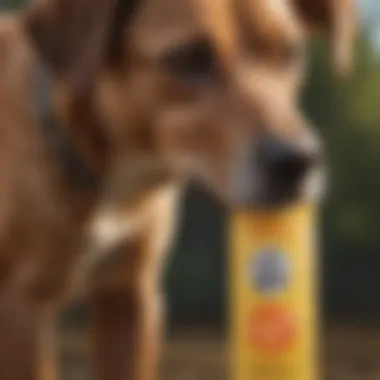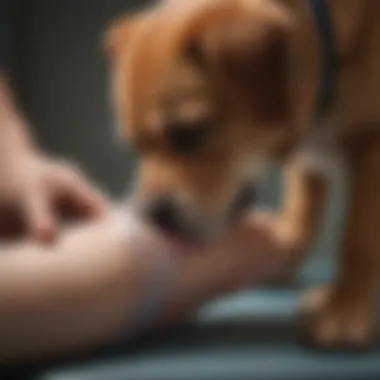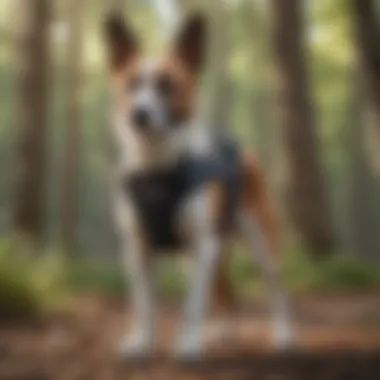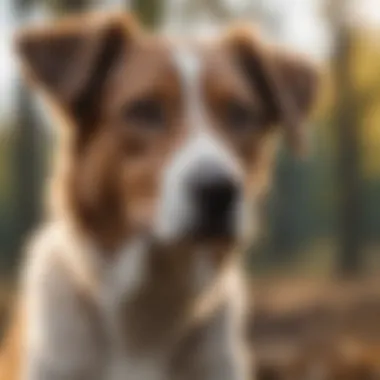Recognizing Signs of Cruciate Ligament Tear in Dogs


Intro
Understanding the signs of a cranial cruciate ligament (CCL) tear in dogs is essential for pet owners, veterinarians, and animal enthusiasts. A CCL tear can cause significant discomfort and mobility issues in dogs. Early recognition of the symptoms can expedite diagnosis and treatment, allowing dogs to maintain their quality of life.
Fascinating Facts About the Animal
Dogs, members of the Canidae family, have a fascinating evolutionary history. They have been companions to humans for thousands of years, displaying unique characteristics and behaviors.
Unique Characteristics
Dogs display a variety of sizes, shapes, and temperaments, reflecting their adaptability to different environments. Their keen senses, particularly smell and hearing, make them extraordinary companions. A dog's sense of smell is approximately 10,000 to 100,000 times more sensitive than that of humans, allowing them to detect various scents, including those related to health and safety.
Extraordinary Abilities
Canines are not just pets; they serve vital roles in various fields. From search and rescue operations to therapy and service roles, their extraordinary abilities are unmatched. They can be trained to assist individuals with disabilities, detect drugs, or even sense emotional distress. Recognizing these qualities increases the bond pet owners share with their dogs, enhancing their overall well-being.
Signs of a Tear
When discussing cruciate ligament tears, it’s essential to recognize the signs that may indicate such an injury in dogs. These include:
- Limping or favoring one leg: Dogs will often avoid putting weight on the affected leg.
- Difficulty rising: Owners may notice their dog has trouble getting up after resting.
- Changes in behavior: Increased irritability or reluctance to engage in physical activities can signal discomfort.
- Swelling around the knee: In some cases, swelling may be visibly noticeable.
Prompt veterinary attention can help confirm a diagnosis and lead to effective interventions.
Diagnosis and Treatment Options
After recognizing signs of a CCL tear, seeking veterinary care is crucial. A vet will perform a physical examination and may recommend imaging tests like X-rays or MRI. Treatment options can include:
- Conservative management: This usually involves rest, anti-inflammatory medications, and weight management.
- Surgical interventions: In more severe cases, surgical procedures such as TPLO (tibial plateau leveling osteotomy) or TTA (tibial tuberosity advancement) may be necessary.
Preventive Measures
Preventing CCL tears involves several proactive measures:
- Regular exercise to maintain a healthy weight
- Joint supplements to support ligament health
- Proper warm-up before vigorous activities
By taking these steps, pet owners can contribute to their dog’s long-term health and mobility.
The End
Recognizing the signs of a cruciate ligament tear in dogs can make a significant difference in their treatment. By understanding the symptoms and potential interventions, dog owners can advocate for their pets effectively. Seeking timely veterinary assistance is essential for optimal outcomes, ensuring that your dog remains a healthy and active member of your family.
Intro to Tears in Dogs
Cranial cruciate ligament (CCL) tears in dogs represent a significant issue in veterinary medicine. Understanding this condition is essential for dog owners and caretakers. Awareness of the signs and symptoms allows for early detection. This knowledge can ultimately improve outcomes for affected dogs.
Understanding the Cranial Cruciate Ligament
The cranial cruciate ligament is a critical structure located in the dog's knee joint. It plays a key role in maintaining joint stability and proper alignment of the femur and tibia. When the CCL tears, it can lead to instability, pain, and reduced mobility in the affected leg. The causes of a CCL tear can range from acute injuries to degenerative changes due to age or overweight conditions. Recognizing the importance of this ligament is vital for interpreting the signs of injury and seeking timely veterinary assistance.
Importance of the in Canine Mobility
The CCL is fundamental to a dog's ability to movement and engage in activities. This ligament allows for normal locomotion, including running, jumping, and climbing stairs. When a dog experiences a CCL tear, it may not only affect physical activities but can also alter the animal's overall quality of life. Therefore, understanding the role of the CCL can encourage proactive measures in health management. Protecting this ligament through weight management and appropriate exercise can aid in prolonging a dog's mobility and comfort as it ages.
Recognizing the signs of a CCL tear and its implications on mobility is crucial for maintaining a dog's active lifestyle and well-being.
Common Symptoms of Tears


Understanding the common symptoms of cranial cruciate ligament (CCL) tears is vital for dog owners and veterinarians. These signs serve as essential indicators, prompting timely veterinary evaluation and intervention. Recognizing symptoms promptly can help in minimizing long-term damage and facilitate better recovery outcomes for the dog. By being familiar with these physical indicators of injury, owners can ensure their pets receive appropriate care sooner rather than later.
Limping or Lameness
Limping or lameness is often the most noticeable sign of a CCL tear. If a dog suddenly shifts its weight off one leg, it’s a clear indicator that something is wrong. Such limping may not be constant. The dog might alternate between limping when it is active or during specific movements, such as running or climbing stairs.
It’s important to pay attention to the severity and duration of the limp. A persistent limp warrants a prompt visit to the veterinarian for further assessment. Ignoring this early symptom may lead to additional complications, including further joint instability, which can exacerbate the condition over time.
Changes in Gait
Changes in a dog's gait can also signal a problem with the CCL. Owners may observe their pet walking with a stiff-legged stance or displaying a hopping motion instead of a smooth stride. The lumbar region may also show signs of compensation, with the dog arching its back differently.
These alterations might be subtle at first but can escalate as the injury worsens. Monitoring how your dog moves on different surfaces and terrains can provide valuable insights into the extent of the injury. Early detection of gait changes can lead to quicker diagnostic actions, which is crucial for the dog’s comfort and mobility.
Swelling Around the Joint
Swelling around the knee joint is a significant physical symptom of CCL tears. When the ligament is compromised, it can lead to an accumulation of fluid in the joint, known as effusion. This swelling is not always visibly apparent but can often be felt when gently palpating the area.
Owners should look for any discrepancies between the knees. If one joint is noticeably larger than the other or appears warm to the touch, this may signal an underlying issue. The presence of swelling highlights the importance of early veterinary intervention, as it can prompt accurate diagnosis and treatment plans.
Pain Response During Manipulation
Dogs often exhibit pain during manipulation of the affected leg, which can be assessed during a physical examination by a veterinarian. This pain might manifest as flinching, growling, or pulling away when pressure is applied to the knee joint. A heightened pain response when the joint is flexed or extended is particularly telling.
Understanding pain responses can empower dog owners to communicate effectively with their veterinarians. It aids in diagnosing the severity of the injury and helps ensure the best treatment plan is devised. Observing any changes in behavior during simple tasks can also gauge how much discomfort the dog is experiencing.
In summary, recognizing these symptoms as early warning signs is essential for effective management of CCL tears in dogs. Timely intervention can greatly improve health outcomes and overall quality of life.
Behavioral Changes in Affected Dogs
Understanding the behavioral changes in dogs with a cruciate ligament tear is crucial for owners. Changes in behavior often reflect pain and discomfort and can significantly affect a dog's quality of life. Identifying these shifts can lead to early recognition of potential issues, prompting timely veterinary care.
Decreased Activity Level
One of the first signs of a CCL tear might be a noticeable decrease in a dog's activity level. A formerly energetic dog may suddenly prefer resting, choosing to stay in one place rather than engaging in usual activities like walking or playing. This reluctance is often a response to pain or instability in the affected limb. Owners should monitor their pets closely. Changes in activity can reveal underlying damage that needs attention. Prioritizing immediate intervention can prevent further complications in the dog's joints.
Reluctance to Engage in Play
Dogs that once displayed a vibrant enthusiasm for play can show reluctance or total disinterest when faced with physical discomfort. The desire to join a game or chase after their favorite toy could diminish significantly. This behavior indicates both physical pain and a change in mood. It’s important for owners to note this behavior as a signal that their pet may be in distress. Socializing is fundamental to a dog’s well-being. Addressing this reluctance not only improves their mood, but it can also help to rebuild their physical strength, provided they are directed into appropriate activities.
Changes in Feeding Habits
An additional indicator of a CCL tear can be changes in a dog's appetite. Some dogs may eat less due to pain, while others may turn to food for comfort, leading to overeating. These shifts can be subtle but are crucial for owners to observe. A decrease in appetite can also lead to weight loss, which complicates recovery if a surgical intervention is needed. Therefore, monitoring feeding habits can serve as an early warning sign of underlying medical issues. Ensuring that nutrition needs are met is important. Collaborating with a veterinarian to modify feeding strategies can support a dog through recovery or management of their condition.
Diagnostic Procedures
Evaluating a dog's health following a suspected cranial cruciate ligament (CCL) tear is vital. Diagnostic procedures help confirm the presence of an injury and guide treatment. Understanding these processes allows for timely intervention, which can significantly affect a dog's recovery and quality of life. In this section, we will look at two crucial components of diagnosis: the veterinary physical examination and imaging techniques such as X-rays and MRI.
Veterinary Physical Examination
The first step in assessing a possible CCL tear is conducting a thorough physical examination by a veterinarian. This evaluation is fundamental for several reasons. It enables the veterinarian to assess the dog's mobility, pain response, and overall joint health. They will often perform specific tests, such as the cranial drawer test, to evaluate the stability of the knee joint.
During the examination, the veterinarian may also check for signs of swelling or heat in the affected area. Observing the dog's reactions during movement can further indicate which leg is injured. By noting these factors, the veterinarian gains critical insights that inform subsequent diagnostic steps.
Considerations during this examination include:
- Observation of gait: Watching how the dog walks can reveal lameness or discomfort.
- Joint manipulation: Carefully moving the joint can trigger a pain response if the ligament is torn.
- Palpation of the knee: Feeling the joint may help detect swelling or heat.


The veterinary physical examination is a critical first step in diagnosing CCL tears in dogs. It can reveal important information that shapes further diagnostic actions.
Imaging Techniques: X-rays and MRI
After a physical examination, imaging techniques play an essential role in confirming a diagnosis. X-rays and MRI are among the most common methods utilized in these situations. Each has specific advantages that contribute to understanding the extent of the injury.
X-rays
X-rays are often the initial imaging technique used. They provide a good view of the bones surrounding the knee, helping to rule out fractures or other bone-related issues. However, they do have limitations. X-rays do not directly show soft tissue, so while they can reveal joint effusion or changes in bone structure, they may not easily identify a ligamental tear.
MRI
Magnetic Resonance Imaging (MRI) offers a detailed look at soft tissues, making it particularly useful in evaluating CCL tears. MRI is capable of visualizing the ligament itself, allowing for a precise diagnosis. This technique can reveal tears, degeneration, and any concurrent damage in soft tissues.
While MRIs can be more costly and time-consuming than X-rays, the information they provide can be invaluable. When a comprehensive understanding of the injury is needed, MRI becomes a preferable tool.
In summary, accurate diagnostic procedures are crucial in identifying CCL tears in dogs. The combination of a veterinary physical examination followed by appropriate imaging techniques enables a thorough assessment. This process not only confirms the injury but also lays the groundwork for effective treatment options.
Treatment Options for Tears
Addressing a cranial cruciate ligament (CCL) tear in dogs requires a careful assessment of various treatment options. The importance of selecting the right approach cannot be overstated, as it directly influences the recovery process and overall mobility of the dog. This section delves into both conservative management strategies and surgical interventions, providing readers with a comprehensive understanding of each choice available.
Conservative Management
Conservative management of CCL tears emphasizes non-invasive treatments, allowing for a holistic recovery. This can be effective, especially in cases where surgery might not be immediately necessary or is not feasible due to other health concerns. It includes methods such as rest, medication, and physical therapy.
Rest and Restricted Activity
Rest and restricted activity are essential aspects of conservative management. The primary aim here is to minimize any strain on the injured ligament. This practice is often a beneficial choice because it reduces inflammation and gives the body time to heal. Prolonged rest allows the ligament to recover more efficiently, which can prevent further injury.
The unique feature of rest is its simplicity and cost-effectiveness. Owners can implement a resting regimen with minimal resources, primarily focusing on limiting their dog’s movement. However, one disadvantage is the potential for behavioral issues if a dog is too active during recovery, leading to frustration.
Medication for Pain Management
Medication for pain management plays a crucial role in treating CCL tears. Anti-inflammatory medications can significantly aid in minimizing pain and swelling. This is a popular choice because it helps maintain the dog's quality of life during the healing process.
A unique aspect of pain management medications is that they can offer relief while the dog rests, making it easier for owners to ensure their pets remain inactive. However, care must be taken with dosages and potential side effects. Regular veterinary consultations are important to monitor any adverse reactions.
Physical Therapy Approaches
Physical therapy approaches are increasingly recognized as effective in promoting recovery from CCL injuries. Therapeutic exercises tailored to the dog's needs can enhance strength and flexibility in the surrounding muscles and joints. This choice is sought after as it supports not only recovery but also overall musculoskeletal health.
Physical therapy's unique feature is its ability to combine science with rehabilitation. Various techniques, such as hydrotherapy and specific stretches, can be employed. Nevertheless, the downside is that it requires commitment from both the owner and the therapist, which may not be feasible for all.
Surgical Interventions
When conservative management is insufficient, surgical interventions become essential. They aim to restore functionality and stability to the knee joint, addressing the underlying problem rather than just managing symptoms.
Overview of Surgical Techniques
There are several surgical techniques available, with each designed to stabilize the joint effectively. The importance of understanding these options lies in the customized approach veterinarians can take depending on the specific case. This knowledge is beneficial for owners as they navigate their choices, ensuring informed decisions for their pets.
A unique feature of surgical interventions is their ability to resolve the issue more rapidly than conservative methods, often leading to an earlier return to normal activities. However, surgeries involve inherent risks and a commitment to post-operative care, making it critical for owners to weigh their options thoroughly.
Post-operative Care and Rehabilitation
Post-operative care and rehabilitation are fundamental after any surgical intervention. These steps are vital for ensuring the effectiveness of the surgery and minimizing complications. This phase is crucial as proper rehabilitation can greatly influence the success of the procedure, equipping the dog for a return to active life.


The unique feature of post-operative care is its comprehensive approach, which includes medication, controlled physical activity, and follow-up visits. Owners must remain diligent during recovery, as neglecting these aspects can lead to setbacks. Nonetheless, some may find the requirements challenging, requiring diligence and patience.
Understanding all potential treatment options for a CCL tear empowers dog owners to make well-informed decisions that align with their pet's health and lifestyle.
Rehabilitation and Recovery
Rehabilitation after a cranial cruciate ligament (CCL) tear is crucial for the dog's healing process. This stage is not merely about treating the injury but also about restoring the dog's overall strength and mobility. Effective rehabilitation can significantly enhance the quality of life for the affected dog and can help avoid future injuries. Consequently, a well-structured rehabilitation program can aid in returning a dog to its pre-injury activity level, ensuring they continue to play, run, and enjoy life.
The Role of Physical Therapy
Physical therapy plays a pivotal role in recovery from a CCL tear. Devised by trained professionals, a tailored physical therapy program addresses individual needs based on the dog's condition and recovery stage. Common techniques may include:
- Range of Motion Exercises: These help maintain joint flexibility, preventing stiffness and promoting healing.
- Strengthening Exercises: These target specific muscle groups around the knee to provide better support and stability.
- Aquatic Therapy: Underwater exercises reduce stress on joints while offering resistance, thereby aiding recovery.
- Manual Therapy: This includes massage techniques that encourage blood flow and reduce muscle tension.
Incorporating physical therapy into a dog's rehabilitation plan helps speed up recovery. Additionally, the professional guidance offered in therapy ensures that the recovery process is both safe and effective. Consistent attendance and engagement in these sessions can lead to a higher success rate in returning to normal function.
Home Care Strategies
Home care is equally important as professional therapy. Owners play a significant role in the recovery process through conscientious home management. Some beneficial strategies include:
- Controlling Activity Levels: Limit jumping, running, and playing until the veterinarian gives the go-ahead.
- Creating a Comfortable Space: Ensure the dog has a quiet and comfortable area for rest, away from distractions.
- Hydration and Nutrition: Offer a balanced diet to facilitate healing. Maintaining hydration can also aid in joint health.
- Weight Management: Keeping the dog’s weight in check can reduce stress on the knee joint, aiding healing.
- Regular Check-Ins: Monitor for any changes in symptoms or behavior that may prompt a visit to the veterinarian.
By implementing these home care strategies, dog owners can contribute to a smoother, more effective recovery. Every small step taken can have a profound impact on the dog’s journey back to health.
Rehabilitation is a journey, not just a destination. A comprehensive approach, both at the veterinary office and at home, is essential for optimal recovery.
Preventive Measures
Preventive measures play a crucial role in promoting overall canine health. They can reduce the likelihood of a cranial cruciate ligament (CCL) tear. Understanding how to implement these measures can benefit not just the dog's physical condition but also its quality of life.
It is important for dog owners to prioritize preventive care. Regular check-ups with a veterinarian can identify potential issues early. This proactive approach can lead to better management of weight, exercise, and overall health.
Maintaining Optimal Weight
Maintaining an optimal weight is vital in preventing CCL tears in dogs. Excess weight increases stress on joints, particularly the knees. This added pressure can lead to injuries over time. Keeping dogs at a healthy weight reduces the strain on their ligaments and joints, thus lowering the risk of tears.
Here are some tips on how to achieve and maintain your dog's ideal weight:
- Regular Veterinary Check-ups: Regular exams can help monitor your dog's weight
- Nutrition: Provide a balanced diet tailored to your dog’s age, size, and activity level
- Portion Control: Measure their food to avoid overfeeding
- Healthy Treats: Offer low-calorie treats instead of high-fat options
Excess weight is associated with various health issues, including joint problems.
Establishing an Exercise Routine
Establishing a consistent exercise routine is essential. Regular physical activity helps strengthen the muscles around the joints. This support can stabilize and protect the CCL. Exercise also aids in maintaining a healthy weight.
When setting an exercise routine, consider the following:
- Age and Breed: Tailor activities to your dog’s age and breed needs
- Variety in Activities: Mix up exercises to keep your dog engaged, such as walking, swimming, or playing fetch
- Gradual Increase in Intensity: Introduce new activities slowly to avoid strain or injury
- Rest Days: Incorporate rest days to allow recovery
Regular exercise can enhance not just physical health but also overall behavioral health, leading to a happier and healthier dog.
End
Understanding the signs of a cranial cruciate ligament (CCL) tear in dogs is crucial for pet owners. Early recognition of symptoms can lead to timely intervention and better outcomes. It is important for owners to be aware of the physical and behavioral changes that indicate a problem. This ensures that they can seek veterinary help promptly, preventing further injury and complications. Recognizing these signs early can lead to a faster recovery, which ultimately enhances the quality of life for the dog.
Summary of Key Points
- Importance of Awareness: Knowing the signs of a CCL tear allows for early veterinary intervention, which is key to successful treatment.
- Common Symptoms: Limping, changes in gait, swelling, and behavioral changes provide insight into the dog's condition.
- Diagnostic and Treatment Options: Understanding the diagnostic procedures and treatment plans available enables owners to make informed decisions regarding their pets' health.
- Preventive Measures: Maintaining proper weight and establishing a regular exercise routine can help reduce the risk of CCL injuries.
Encouragement for Dog Owners
It is imperative for dog owners to stay vigilant about their pets’ health, especially concerning joint issues like CCL tears. Regular veterinary check-ups are essential in monitoring the well-being of dogs, particularly those at risk due to age, weight, or activity levels. Owners should also engage in discussions with veterinarians about preventive strategies and treatment options. By being proactive about signs of CCL tears, every owner can contribute to their dog's overall health and mobility.
Assessing your dog's activity and behavior regularly is an investment in their health. Don't hesitate to consult a veterinarian if you notice any concerning signs.







